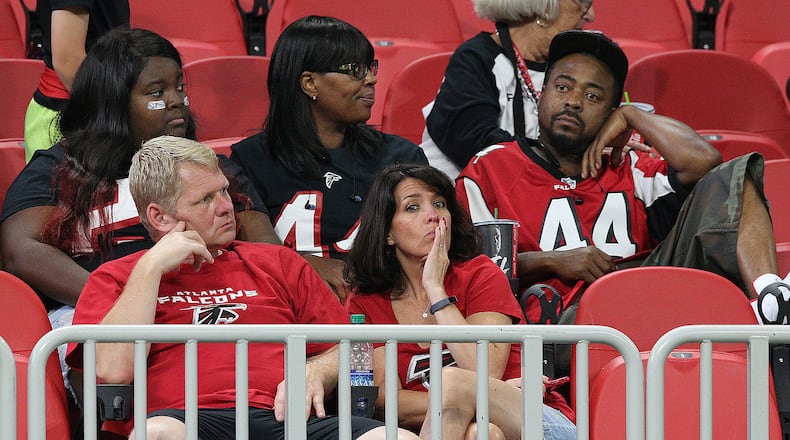Between them, the Falcons and Atlanta United announced attendance of more than 70,000 at 16 home games last year. But neither team reached that level even once in terms of actual attendance, according to figures provided by Mercedes-Benz Stadium to a state agency.
The Falcons announced average attendance of 72,898 at their eight regular-season home games, but actually drew almost 9,000 fewer per game to the stadium — an average of 64,022. Three times during a disappointing season, the Falcons’ real attendance was more than 11,000 below the announced figure. For the home finale, the crowd was 15,614 fewer than announced.
Atlanta United, meanwhile, announced average attendance of 53,002 for 17 regular-season home games, but actually drew an average of 47,123 to the stadium for those games. Including playoffs, the eight United crowds announced as 70,000-plus ranged from 61,594 to 69,004. Of the 11 crowds announced as 45,000-plus with the stadium’s upper deck closed, six were below 40,000 and none above 41,500.
The crowd figures for last year’s Falcons and Atlanta United games, obtained this week by The Atlanta Journal-Constitution from the Georgia World Congress Center Authority through an open-records request, reflect the differing definitions of “attendance” in professional sports. The records, submitted to the GWCCA by the stadium, show the “actual” attendance — the number of people in the building for games. But the Falcons and Atlanta United, like all other NFL and MLS teams, publicly announce at each game the number of tickets distributed as the attendance.
“Tickets distributed” includes sold tickets and complimentary tickets, regardless of whether the tickets are used. That means teams can distribute some unsold tickets by giving them away — and then count them in the attendance even if the recipients don’t show up for the games. Teams announce the number of tickets distributed as their official attendance rather than announcing a more accurate metric: the number of people in the stadium as measured by turnstile counts or ticket scans.
“Teams want to announce they’ve got as big an attendance number as possible,” said J.C. Bradbury, a sports economist at Kennesaw State. “… I think it’s mostly marketing.”
But to assess the economic impact on a city or region of a publicly funded stadium, it’s important to know the number of people actually attending the events, he said.
“Absolutely, using those tickets distributed numbers inflates the amount of people who might be having an economic impact,” Bradbury said.
Rich McKay, president and CEO of the Falcons and president of Arthur Blank’s sports and entertainment group, said the organization hasn’t considered announcing the number of people in the building at each game instead of, or in addition to, announcing the number of tickets distributed.
“We could debate which is a better number,” McKay said. “We just always have gone with the (tickets distributed) number that we share with our partners and report to the league. The league doesn’t ask us for the other number.”
Other Atlanta teams also announce something other than the turnstile or ticket scan counts as their attendance. The Hawks say they announce tickets distributed, as do other NBA teams. The Braves say they announce the number of tickets sold, which is the MLB requirement. Actual attendance figures aren’t available for Hawks or Braves games, but often appear to be well below the announced attendance.
The AJC, which last month reported Mercedes-Benz Stadium's actual attendance for December events, obtained additional records this week covering all events at MBS in 2018. The records were sent on a monthly basis by MBS staff to the Georgia World Congress Center Authority, a state agency that has an oversight role over the stadium.
Several times during the year, GWCCA staffers sent emails to stadium staffers saying they were seeking the “actual attendance.” In a July email with the subject line “Actual Attendance Verification,” a GWCCA staffer wrote: “(W)e need (the) numbers to come from you guys and we need them to be accurate.” The GWCCA sought the figures for use in economic impact reports.
The figures provided to the GWCCA by the stadium show a wide gap in some cases between announced attendance and actual attendance. Some discrepancy is inevitable, because there always will be some fans with tickets who don’t attend for one reason or another. A few thousand widely scattered empty seats are generally not noticeable in a stadium that seats more than 70,000, but the number of no-shows became glaring as the Falcons struggled to a 7-9 record last season.
Although the Falcons’ smallest announced crowd was 71,985, the number of fans in the stadium dipped to 62,455 for a late-September game against Cincinnati, 61,206 for a mid-October game against Tampa Bay, 60,626 for an early-December game against Baltimore and 56,470 for the home finale Dec. 16 against Arizona, according to the figures provided to the GWCCA. About 22 percent of people with tickets were no-shows for the finale, meaning many season-ticket holders stayed away.
“I’ve been in this long enough to know that the responsibility for people going to games is on us and our performance,” McKay said. “… There are two things that drive in-house attendance: It’s going to be record of your team and where you are in that season, and it’s going to be opponent. We always say that we need to own it. We need to own those numbers, and we need to get those people to the games.
“We just need to win football games and give our fans a product that they’re going to come see.”
While Atlanta United’s attendance is an overwhelming success story by any measure, some of the announced milestones — such as the 70,000-plus crowds — aren’t matched by the figures submitted by the stadium to the GWCCA. The biggest difference was for a Sept. 22 match against Real Salt Lake. The announced attendance was 72,017, but the number in the building was 61,594.
For United’s MLS matches with the upper deck closed last season, the actual attendance averaged 39,885, vs. an announced 45,083. The stadium’s soccer seating capacity in that configuration is 42,500, United and stadium officials said when the building opened.
Atlanta United has set MLS attendance records on numerous occasions, most recently at the MLS Cup final on Dec. 8, when the announced crowd was 73,019 and the actual attendance 69,004 (the highest at an Atlanta United game last season). Official MLS attendance records are based on tickets distributed, so United’s records stand.
The documents obtained from the GWCCA also showed the attendance for other events at Mercedes-Benz Stadium last year, including: 65,985 for the MLS All-Star game, compared to an announced 72,317; 69,614 for the SEC Championship football game, versus an announced 77,141; and 68,413 for the Chick-fil-A Peach Bowl, vs. an announced 74,006.
2018 FALCONS ATTENDANCE
Comparing the announced and actual attendance figures for the Falcons’ eight regular-season home games last season:
Game | Announced | Actual
Sept. 16 vs. Carolina | 72,528 | 64,884
Sept. 23 vs. New Orleans | 74,457 | 69,430
Sept. 30 vs. Cincinnati | 71,985 | 62,455
Oct. 14 vs. Tampa Bay | 72,665 | 61,206
Oct. 22 vs. New York Giants | 72,756 | 67,494
Nov. 18 vs. Dallas | 74,447 | 69,613
Dec. 2 vs. Baltimore | 72,262 | 60,626
Dec. 16 vs. Arizona | 72,084 | 56,470
2018 ATLANTA UNITED ATTENDANCE
Comparing the announced and actual attendance figures for Atlanta United’s regular-season and post-season home games last year:
Game | Announced | Actual
March 11 vs. D.C. United | 72,035 | 67,011
March 17 vs. Vancouver | 45,003 | 41,050
April 7 vs. Los Angeles FC | 45,207 | 41,431
April 15 vs. New York City FC | 45,001 | 40,892
April 28 vs. Montreal | 45,039 | 38,636
May 9 vs. Sporting KC | 44,696 | 39,568
May 20 vs. NY Red Bulls | 45,089 | 39,934
June 2 vs. Philadelphia | 45,140 | 40,689
June 20 U.S. Open Cup | 41,012 | 32,347
June 24 vs. Portland | 45,116 | 39,342
June 30 vs. Orlando | 71,932 | 66,009
July 15 vs. Seattle | 72,243 | 65,266
July 21 vs. D.C. United | 45,087 | 39,692
Aug. 4 vs. Toronto | 45,191 | 40,531
Aug. 19 vs. Columbus | 45,303 | 39,581
Sept. 22 vs. Real Salt Lake | 72,017 | 61,594
Oct. 6 vs. New England | 45,122 | 37,277
Oct. 21 vs. Chicago | 71,812 | 62,581
Nov. 11 vs. NYCFC (playoffs) | 70,526 | 65,142
Nov. 25 vs. NY Red Bulls (playoffs) | 70,016 | 62,788
Dec. 8 vs. Portland (MLS Cup final) | 73,019 | 69,004
Source: "Announced" is the figure announced at the event, based on tickets distributed. "Actual" is the figure submitted by Mercedes-Benz Stadium to the Georgia World Congress Center Authority for each event.
About the Author
Keep Reading
The Latest
Featured




